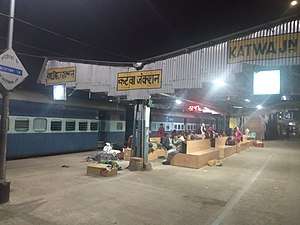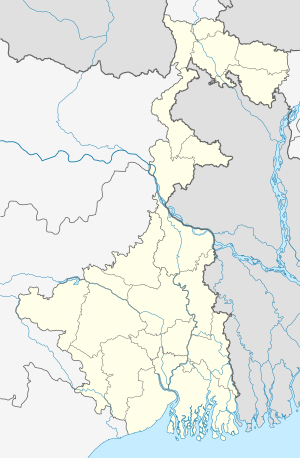Katwa Junction railway station
Katwa is a Kolkata Suburban Railway Junction Station on the Bandel-Katwa line and the Barharwa-Azimganj-Katwa loop. It is located in Purba Bardhaman district in the Indian state of West Bengal. It serves Katwa and the surrounding areas.
Bandel–Katwa line | ||||||||||||||||||||||||||||||||||||||||||||||||||||||||||||||||||||||||||||||||||||||||||||||||||||||||||||||||||||||||||||||||||||||||||||||||||||||||||||||||||||||||||||||||||||||||||||||||||||||||||||||||||||||||||||||||||||||||||||||||||||||||||||||||||||||||||||||||||||||||||||||||||||||||||||||||||||||||||||||||||
|---|---|---|---|---|---|---|---|---|---|---|---|---|---|---|---|---|---|---|---|---|---|---|---|---|---|---|---|---|---|---|---|---|---|---|---|---|---|---|---|---|---|---|---|---|---|---|---|---|---|---|---|---|---|---|---|---|---|---|---|---|---|---|---|---|---|---|---|---|---|---|---|---|---|---|---|---|---|---|---|---|---|---|---|---|---|---|---|---|---|---|---|---|---|---|---|---|---|---|---|---|---|---|---|---|---|---|---|---|---|---|---|---|---|---|---|---|---|---|---|---|---|---|---|---|---|---|---|---|---|---|---|---|---|---|---|---|---|---|---|---|---|---|---|---|---|---|---|---|---|---|---|---|---|---|---|---|---|---|---|---|---|---|---|---|---|---|---|---|---|---|---|---|---|---|---|---|---|---|---|---|---|---|---|---|---|---|---|---|---|---|---|---|---|---|---|---|---|---|---|---|---|---|---|---|---|---|---|---|---|---|---|---|---|---|---|---|---|---|---|---|---|---|---|---|---|---|---|---|---|---|---|---|---|---|---|---|---|---|---|---|---|---|---|---|---|---|---|---|---|---|---|---|---|---|---|---|---|---|---|---|---|---|---|---|---|---|---|---|---|---|---|---|---|---|---|---|---|---|---|---|---|---|---|---|---|---|---|---|---|---|---|---|---|---|---|---|---|---|---|---|---|---|---|---|---|---|---|---|---|---|---|---|---|---|---|---|---|---|---|---|---|---|
| ||||||||||||||||||||||||||||||||||||||||||||||||||||||||||||||||||||||||||||||||||||||||||||||||||||||||||||||||||||||||||||||||||||||||||||||||||||||||||||||||||||||||||||||||||||||||||||||||||||||||||||||||||||||||||||||||||||||||||||||||||||||||||||||||||||||||||||||||||||||||||||||||||||||||||||||||||||||||||||||||||
Katwa | |
|---|---|
| Kolkata Suburban Railway Junction Station | |
 Katwa railway station | |
| Location | Station Road, Katwa, West Bengal India |
| Coordinates | 23°38′25″N 88°07′25″E |
| Elevation | 16.077 meter 21 metres (69 ft) |
| Owned by | Indian Railways |
| Operated by | Eastern Railway |
| Line(s) | Bandel-Katwa line Barharwa-Azimganj-Katwa loop Bardhaman-Katwa line Ahmadpur–Katwa line |
| Platforms | 7 |
| Construction | |
| Structure type | Standard (on ground station) |
| Parking | only for 2 Wheeler's |
| Other information | |
| Status | Functioning |
| Station code | KWAE |
| Zone(s) | EASTERN RAILWAY |
| Division(s) | Howrah |
| History | |
| Opened | 1913 |
| Electrified | 1994-96 with 25 kV overhead line |
| Previous names | East India Railway Company |
| Location | |
 Katwa Location in West Bengal  Katwa Location in India | |
History
In 1913, the Hooghly–Katwa Railway constructed a 1,676 mm (5 ft 6 in) wide broad gauge line from Bandel to Katwa, and the Barharwa–Azimganj–Katwa Railway constructed the 1,676 mm (5 ft 6 in) wide broad gauge Barharwa-Azimganj-Katwa Loop Line.[1][2]
The 53 km (33 mi) long 762 mm (2 ft 6 in) wide narrow gauge Burdwan Katwa Railway was opened in 1915 as part of Mc Leod's Light Railways, taken over by Eastern Railway in 1966 and closed in 2010.
The 53 km (33 mi) long 762 mm (2 ft 6 in) wide narrow gauge Ahmedpur Katwa Railway was opened in 1917 as part of Mc Leod's Light Railways and taken over by Eastern Railway in 1966. It was closed in 2013 for conversion to 1,676 mm (5 ft 6 in) wide broad gauge and electrification.[3][4]
Gauge conversion
The Bardhaman-Katwa line, after conversion from narrow gauge to electrified broad gauge, was opened to the public on 12 January 2018.[5]
The track from Katwa to Ahmedpur line after conversion from narrow gauge to broad gauge, was opened to the public on 24 May 2018.
Electrification
Electrification of the Bandel-Katwa line was completed with 25 kV AC overhead system in 1994-96.[6]
Narrow gauge travel
Here is a description of narrow gauge travel (now closed):
The land west of the Hooghly, though still alluvial and flat, is not as wet as riverine Bengal. Its fields, though usually covered with close-cropped green grass, bear but one crop a year and lie open, instead of being divided by watercourses and frequent villages. Altogether they do nothing to prevent the BK Railway from following a straight surveyed line, or to stop its trains from traveling at an even pace marked by the measured clunking of four-wheeled carriages on rail joints. My train from Burdwan stopped regularly, sometimes to shunt or to cross a southbound service. At each station the passenger load increased, so that after two stops the man opposite had to give up sleeping on the seat, and after several more there were fowls underfoot and small boys and women sitting on the floor and young men hanging on while standing on the footboards. So we rounded the curve into Katwa – doors open, dhotis flapping, all bound for Katwa market. A secondary main line of the Eastern Railway also passes through Katwa, the headquarters of the two narrow gauge lines being alongside its station. Their loco shed had several more Bagnalls and, among others, a 0-6-0 Simplex or two. In company days each engine was owned by the BK or AK but used on either line – I dare say it all came out in the accounts. Another pleasing feature of McLeod’s accountancy was that the second class fare was only 20% above the third and the first that much again, instead of the 1:2 ratio preferred by the government. This meant that I could afford second class to Ahmadpur – the seedy red cushion on the seat was not worth it, but the lessened crowd was. This train left from No. 2 road of McLeod’s station (never mind that it had no platform) and wasted no time in making arrangements to run third-rail along the East Indian broad gauge for the first few miles out from Katwa, in order to share a bridge over one of the sluggish anabranches that meandered over the plain. Once AK was on its independent way, the regular jolting of the carriages combined with the monotonous scenery to induce sleepiness in all the passengers and perhaps the train itself. Matters were not helped by the Bengal midday, with the sunlight diffused by a high mist and yet stifling us with heat.[7]
References
- R.P.Saxena. "Indian Railway History timeline". Archived from the original on 14 July 2012. Retrieved 20 November 2011.
- "The Chronology of Railway development in Eastern Indian". railindia. Archived from the original on 16 March 2008. Retrieved 2 May 2013.
- "Ahmedpur-Katwa_Railway". fibis. Retrieved 2 May 2013.
- Chakraborty, Snehamoy. "Emotions pasted – One last run". The Telegraph, 14 January 2013. Archived from the original on 12 November 2008. Retrieved 2 May 2013.
- "Baro rail Katwae, jamlo bhidr (Big railway in Katwa, crowd gathers)". Bengali. Ananda Bazar Patrika, 13 January 2018. Retrieved 13 January 2018.
- "History of Electrification". IRFCA. Retrieved 2 May 2013.
- Manning, Ian. "From Bengal towards Nagpur". The Katwa Railways. IRFCA. Retrieved 2 May 2013.
External links
| Preceding station | Indian Railway | Following station | ||
|---|---|---|---|---|
| Terminus | Eastern Railway zone | |||
| Terminus | Eastern Railway zone | |||
| Preceding station | Kolkata Suburban Railway | Following station | ||
toward Howrah Junction | Eastern Line | Terminus | ||
toward Howrah Junction | Eastern Line |